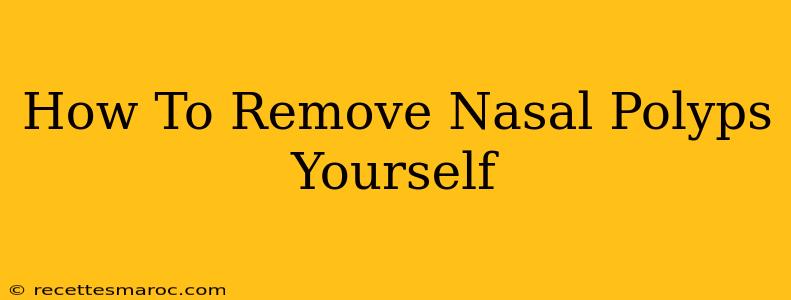How To Remove Nasal Polyps Yourself? Don't.
Attempting to remove nasal polyps yourself is extremely dangerous and strongly discouraged. Nasal polyps are benign growths in the nasal passages, but improper removal can lead to serious complications. This article will explain why you should never try to remove them at home and what safe options you should consider instead.
The Dangers of At-Home Nasal Polyp Removal
Trying to remove nasal polyps yourself can result in several serious problems, including:
-
Severe Bleeding: The nasal passages are highly vascular, meaning they have a rich blood supply. Attempting to remove a polyp can cause significant bleeding, potentially leading to blood loss and requiring medical intervention.
-
Infection: Introducing foreign objects or unclean instruments into your nasal passages increases the risk of infection. This can range from minor irritation to serious bacterial or fungal infections.
-
Damage to Nasal Tissues: Improper removal can damage delicate nasal tissues, leading to scarring, impaired breathing, and long-term nasal problems.
-
Incomplete Removal: Even if you manage to remove a portion of a polyp, it's highly unlikely you'll remove the entire growth. Remaining polyp tissue can regrow, and the incomplete removal could make future medical treatment more difficult.
-
Aspiration: A polyp, or fragments of it, can be inhaled into the lungs during an attempt at self-removal, causing respiratory problems.
Safe and Effective Treatment Options
Instead of resorting to potentially harmful at-home remedies, focus on safe and effective treatments recommended by medical professionals. These include:
-
Corticosteroid Nasal Sprays: These sprays are often the first line of defense against nasal polyps, helping to reduce inflammation and shrink the polyps.
-
Oral Corticosteroids: In more severe cases, your doctor may prescribe oral corticosteroids to reduce inflammation systemically.
-
Surgical Removal: For larger or persistent polyps that don't respond to medication, surgical removal might be necessary. This is a safe procedure performed by trained specialists in a controlled medical setting. Different surgical techniques exist, including endoscopic sinus surgery, which is minimally invasive.
-
Saline Nasal Irrigation: Rinsing your nasal passages with a saline solution can help to clear out mucus and provide some relief from symptoms associated with nasal polyps, like congestion. However, it will not remove the polyps themselves.
When to See a Doctor
It's crucial to seek medical attention if you suspect you have nasal polyps. Symptoms include:
- Nasal congestion: A persistent stuffy nose.
- Loss of smell (anosmia): Difficulty smelling things.
- Facial pain or pressure: Pain or a feeling of pressure in your face, particularly around your sinuses.
- Postnasal drip: Mucus dripping down the back of your throat.
- Snoring: Increased snoring due to nasal blockage.
- Frequent nosebleeds: Recurring episodes of nosebleeds.
Don't delay seeking professional medical help. Early diagnosis and appropriate treatment can prevent serious complications and improve your quality of life. Your doctor can accurately diagnose your condition and recommend the best course of action for your individual needs. Remember, attempting to remove nasal polyps yourself is never the answer.

